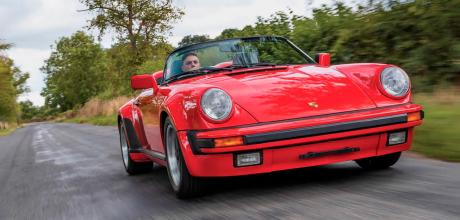A rare UK-spec 1989 Porsche 911 Carrera 3.2 Speedster
Porsche Speedsters have provided a positive twist on the ‘more for less’ concept for almost seven decades, beginning with the 356 in 1954 and taking in various generations of 911, including the Carrera 3.2...
Words Robert Smith and Richard Gooding
Photography Dan Sherwood
A CUT ABOVE
Like a shimmering trophy in Zuffenhausen’s stuffed cabinet of silverware, the Speedster designation is a glistening jewel in the Porsche crown. Marking arguably the purest incarnations of the manufacturer’s most famous sports machines, the short windscreen, lightweight legends first slipped into the Stuttgart brand’s output almost seven decades ago.
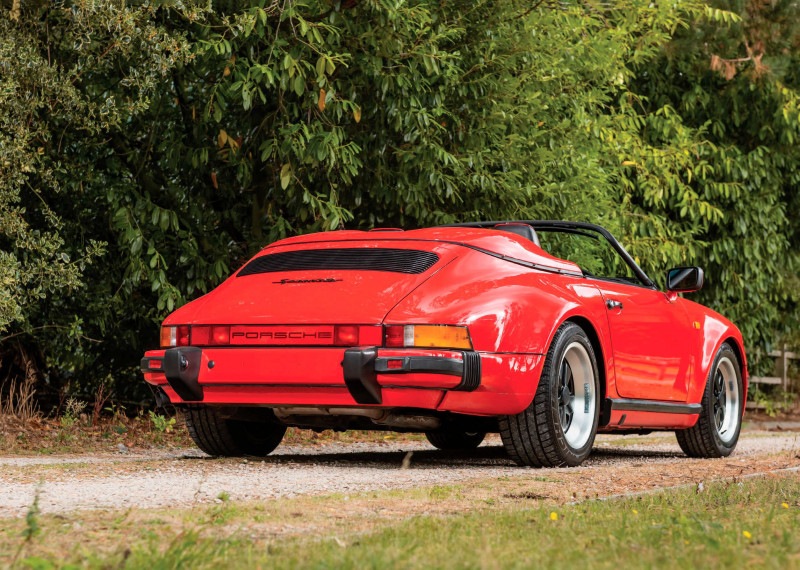
ONE OF ONLY SIXTY-FOUR CARRERA 3.2 SPEEDSTERS SPECIFIED FOR THE C16 UK SALES MARKET
356 no.1 was the poster car for Porsche’s seventieth anniversary celebrations in 2018. The revolutionary two-seated roadster embodied Ferry Porsche’s 1940s vision for a true performance car and set the Porsche path all the way to the present day. The sleek speed machine’s mid-mounted flat-four was replaced by a rear-located boxer for the eventual production 356, a 40bhp pocket rocket powered by a 1,086cc flat-four bolted into coupe or convertible body styles.
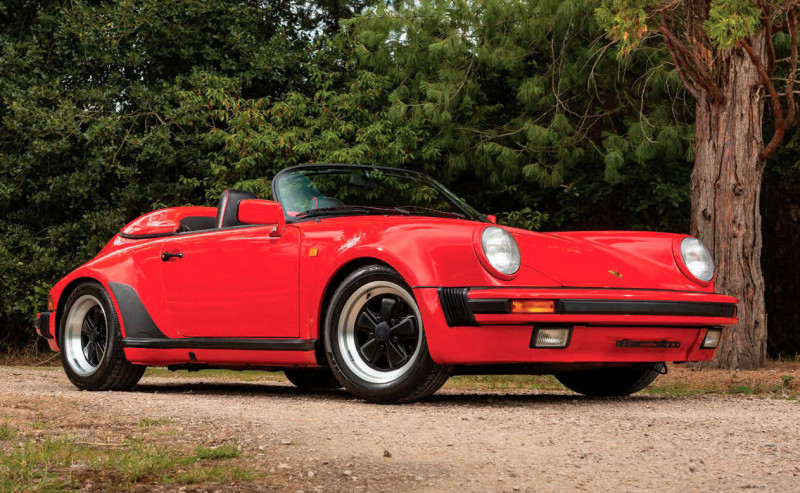
A thousand units sold in the first two years alone, and though this, the first Porsche production car, was celebrated for its stunning looks and impressive performance, many would-be buyers wanted a strippedout, inexpensive version which could be used for everyday commuting before being punished at a track each weekend. Enterprising New York-based European sports car importer, Max Hoffman, recognised the potential for big sales on America’s fast-growing club motorsport scene by converting the 356 into a track-ready road car. Consequently, following his subsequent talks with Ferry Porsche, the 356 Speedster was born in 1954.
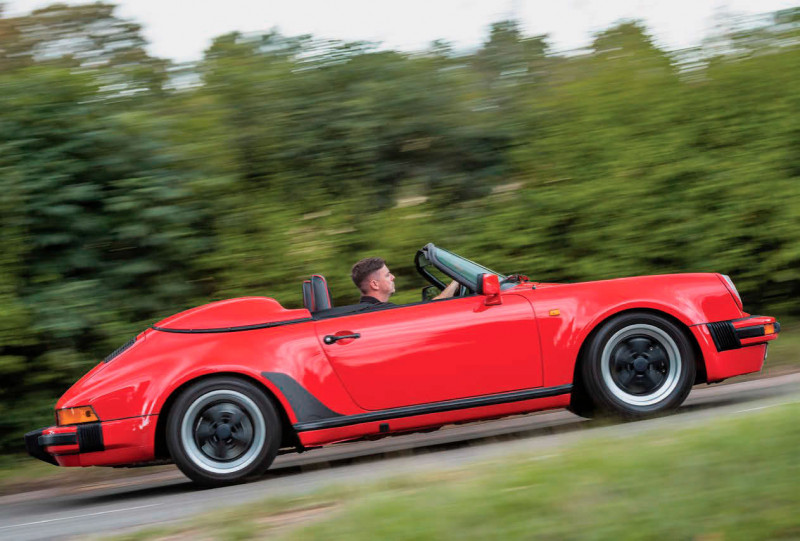
Based on the 356 Cabriolet, the Speedster’s significantly lower price tag was achieved through a combination of eliminated creature comforts, a rain cover and a shorter (and removable) windscreen. Focus on driving dynamics and a slinkier look ensured the model was an instant hit in sun-drenched California, where the 70bhp 1500 Speedster was bought by many enthusiastic amateur racing drivers, including James Dean, one of the era’s leading Hollywood film stars.
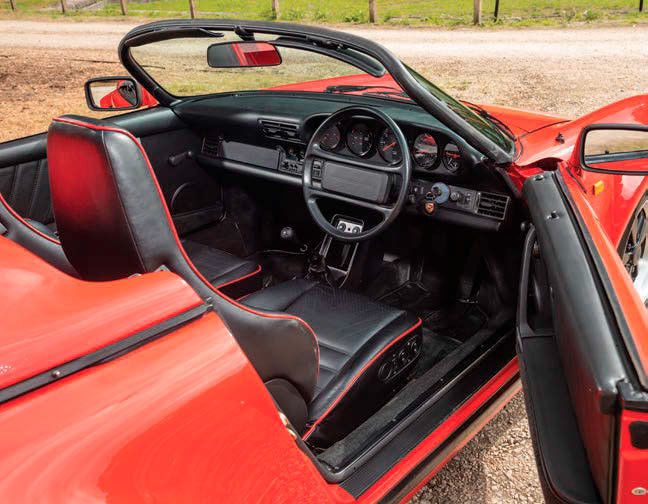
The model reached its peak in 1957 with the launch of the 356 A 1500 GS (Grand Sport) Carrera GT Speedster. Featuring the now legendary Ernst Fuhrmann-designed 1.5-litre, vertical-shaft, four-cam Type 547 engine beneath its rear deck, the potent Porsche transformed the Speedster into a 110bhp flier, earning the model the honour of being the first of the manufacturer’s production cars to break the 200km/h (124mph) barrier. Less than two years later, the 356 Speedster’s days were done, but production volume of more than three thousand units proved Hoffman’s idea was inspired, building on his previous form for recognising lucrative gaps in a crowded marketplace — the Austrian-born entrepreneur was also responsible for sowing the seeds leading to the creation of the W198 Mercedes-Benz 300 SL ‘Gullwing’ and the forefather of all Porsche Speedsters, the 356 America Roadster, an aluminium-bodied, lightweight US-only model introducing slot-in windows, bulk-free buckets and a folding rain cover. Sadly, the expensive Porsche proved to be a commercial disaster, with only sixteen units built and coachbuilder, Heuer-Glaser, driven to bankruptcy due to losing money through sky high production costs on each America Roadster sold. The blueprint for the Speedster, however, was set, and with Hoffman’s efforts in the USA accounting for a third of all Porsches sold, his ideas were taken seriously by Ferry’s team in Stuttgart.

EVEN THOUGH CARRERA 3.2 AND 964 SPEEDSTERS WERE POPULAR, ONLY TWO 993 SPEEDSTERS SAW THE LIGHT OF DAY
Since the 356 Speedster’s introduction all those years ago, many enthusiasts and automotive engineers have been won over by the model, leading to its status as one of the most copied Porsches of all time. Even so, those born in the 1970s and 1980s will argue the Carrera 3.2-based Speedster is the definitive Porsche to wear the emotive nameplate. The idea for a super-slinky 911 was revealed at the 1987 Frankfurt Motor Show, where the 911 Speedster Clubsport was an immediate hit. The Pearl White wonder featured a small wind deflector and a glass-reinforced plastic rain cover accommodating a single occupant. Designed as an idea for trackday applications, the other-worldly Neunelfer’s window frames, windscreen and wiper arms could be removed for even greater wind-cheating potential, although the design was toned down prior to production.
GET A GOOD LOOK
Essentially a low-roof version of the 911 Cabriolet, the 228bhp Carrera 3.2 Speedster’s cut-down windscreen and double body-coloured polyurethane ‘humps’ — covering the manually operated and unlined canvas roof — delivered a striking appearance. Coded as factory option M503, the unusual Porsche made use of a wide ‘Turbo Look’ 911 body, although a narrow-bodied version of the car was available as an option in export markets. The full-fat wider cars looked meaner, though, plus they were fitted with a unique front valance.
Hilariously, drawing attention to how susceptible air-cooled Targas, Cabriolets and Speedsters are to water ingress, the 2,103 buyers willing to stump up the DM110,000 Porsche was asking for each Carrera 3.2 Speedster were required to sign a “weather damage waiver” prior to taking delivery of their new Stuttgartcrested cars in the first half of 1989. Of these, only 171 Porsche customers chose a narrow-bodied Speedster and just 139 of the total number of cars sold were configured for right-hand drive, making the Guards Red example seen on these pages a very rare thing indeed. The car is in the possession of Richard Grout, founder of luxury car storage, sales and servicing specialist, Motorvault, based near Loughborough. “Richard used to be Dealer Principal at Porsche Centre Leicester,” says Nathan Whittington, co-founder of independent Porsche service and sales centre, Quorn Sports & Classics. “My business partner, Carl McCabe, and I were employed at the dealership as technicians. I was there five years, Carl served ten, joining when the place opened. In 2018, the two of us decided to set up shop on our own.”
The dynamic duo didn’t intend to focus their attention exclusively on Porsches, but because of their backgrounds working on Stuttgart’s finest — experience bolstered by time Nathan spent employed in the field of motorsport engineering — local Porsche owners flocking to the new business was something of an inevitability. After all, main dealer knowledge and workmanship is difficult to ignore, especially when it comes without the main dealer price tag. “In addition to car sales, the focus of our work is servicing and maintenance of Porsches,” Nathan continues. “In 2020, Richard left Porsche Centre Leicester to establish Motorvault. Unsurprisingly, he spends much of his time sourcing exceptional 911s. We’ve kept in touch, resulting in him commissioning us to carry out work on some of his sales cars.”
At the time of writing, alongside a brace of McLarens, Alpina-fettled Bimmers and a Ferrari 348, various water-cooled RS, GT3 and GT2-badged 911s are in the Motorvault showroom patiently awaiting new owners. Alongside them, standing out as the only air-cooled 911 in the room, is the 1989 Carrera 3.2 Speedster seen here. “I have no doubt it’s the best right-hand drive example in the UK,” Nathan reasons. One of only sixty-four Carrera 3.2 Speedsters specified for the C16 UK sales market, the car has covered little more than sixteen thousand miles from new. Indeed, it’s not a stretch to describe this open-top rarity as a timewarp 911 — the interior looks barely sat in and the paintwork is completely original from nose to tail. Classic Pilot SX MXX3 N-rated tyres, which Michelin developed in two sizes to suit the 911 Turbo (930), 964 and 993, wrap around the spotless Fuchs five-leaves. Following a major service at Quorn Sports & Classics, the car runs like new, too.
Nathan and Carl’s company name, in case you were wondering, isn’t an admission they’re fanatical about meat substitute foodstuffs. “Quorn is the name of the Leicestershire village we’re based in,” Nathan laughs. Notable residents have included World Cup-winning goalkeeper, Gordon Banks, cricketer, David Gower, and the UK’s most successful diet and fitness expert, Rosemary Conley. It’s an affluent area of the country, meaning there’s no shortage of sports cars in need of Nathan and Carl’s attention, though they’ve seen their customer base spread far beyond the local environ. “With the cost of living pushing up prices at dealerships and marque specialists in London, a number of Porsche owners who live in the capital are travelling to us for servicing and maintenance work on their cars.”
London’s expanding Ultra Low Emission Zone has also played its part, encouraging owners to store their Porsches in remote locations, not least in and around Leicestershire. Irrespective of the model of Porsche they’re based on, all Speedsters are special. The detail in this wide-hipped, red-over-black example, however, is jawdroppingly good. The red piping around the electrically operated, big-bolstered Sports seats, for example, is a sublime touch linking the interior with the car’s Guards Red bodywork, but just as the car was rolling off the assembly line, Porsche was winding up Carrera 3.2 production — the Speedster was a ‘last hurrah’ for what many now consider the best generation of air-cooled 911. The fast-approaching new decade was marked by a new 911 in the shape of the 964, a radically redesigned Neunelfer featuring more integrated bumpers, as well as four-wheel drive derived from the transmission debuting on the earlier 959.
The track-friendly, pumped-up Turbo and RS-badged 964s may have stolen the headlines, but like the Carrera 3.2 Speedster before it, the 964 Carrera 2 Speedster was an enticing proposition for Porsche enthusiasts. Launched in 1992 as a 1993 model and initially unavailable with a ‘Turbo Look’ body style, the new Speedster was offered in standard or RS-aping Clubsport trim. Even the most stripped-out 964 Speedsters retained their radios and air-conditioning. Unfortunately, plans for a build run of three thousand units were well wide of the mark, with only 936 cars eventually rolling off the production line. Just fourteen of them featured a steering wheel on the right, yet regardless of which side the driver sat, the later 964 Speedster’s colour-coded wheels and detachable windscreen ensured the model oozed style as much as it packed performance.
Toward the end of 964 Speedster production, a handful of ‘Turbo Look’ examples were finished at Porsche Exclusive Manufaktur’s Werk 1 assembly facility. Of these special 964s, the last produced was a right-hand drive example finished in Slate Grey, the only Speedster covered in this colour. Commonly referred to as the Sonderwunsch (Special Wishes) Speedster Leichtbau on account of its adoption of lightweight materials, the car was specified by a UK buyer and is widely regarded as the holy grail of all Speedsters — it possesses more power than the standard 964 Speedster (a trait made possible by a blueprinted engine with a custom map and aggressive timing), Turbo brakes, an RS hydraulic brake booster and various other desirable features, including RS aluminium body panels and handmade bumper bars constructed from thin steel.
TWO OF A KIND
Even though Carrera 3.2 and 964-based Speedsters proved popular, only two 993 Speedsters saw the light of day. The first, a 1995 build featuring Tiptronic S and resplendent in dark green with a wood-trim dash and seventeen-inch wheels, was assembled by Porsche Exclusive Manufaktur to celebrate Ferdinand ‘Butzi’ Porsche’s sixtieth birthday. A silver, manual, 4S-bodied 993 Speedster riding on eighteen-inch rims was created for comedian and die-hard Porschephile, Jerry Seinfeld, in 1998. Other 993 Speedsters exist, but these are conversions created by independent specialists, including family-run Porsche servicing, maintenance, modification and restoration centre, MLR Porsche, based in the Staffordshire city of Stoke-on-Trent.
When the next chapter in the Speedster story was written, the 911 had been through seismic changes. In 1997, the water-cooled 996 replaced the final air-cooled 911, the 993, and was the first ground-up, all-new 911 since the model’s introduction in the early 1960s. Both revered and reviled in equal measure, the 996 nevertheless laid a new set of 911 foundations and delivered a fresh raft of hardcore Porsches, leading to a more warmly appreciated evolution of the manufacturer’s flagship model, taking the form of the 997. It was this generation of 911 which delivered the next Speedster. Celebrating the twenty-fifth anniversary of Porsche Exclusive Manufaktur, the 997 Speedster arrived in 2010 with an asking price of €201,682. A tidy sum, but just like buyers who raided their piggy banks for an earlier Porsche wearing Speedster trim, adopters of this most distinctive 997 were rewarded with a car boasting individual styling — the 997 Speedster’s windscreen was seventy-seven millimetres shorter than standard and joined the familiar ‘double hump’ as a clear Speedster identifier, while the model’s wider rear end recalled the ‘Turbo Look’ Carrera 3.2 Speedsters of yore.
A 3.8-litre Power Kit flat-six sent 402bhp through the rear wheels via a seven-speed PDK double-clutch transmission (there was no manual option available). Active suspension and composite brakes added technical icing to an already appetising cake, while additional visual ingredients included tinted headlights with black surrounds, a special front apron and model-specific side skirts. Hot on the heels of the equally retro 997 Sport Classic, just 356 997 Speedsters were built, a number referencing the first Porsche to wear the Speedster name. All 997 Speedsters were equipped with special badging, a manually operated folding roof, a limited-slip differential and a sports exhaust. Colours were limited to Pure Blue or Carrara White, but was the best Speedster yet to come? Sitting on a new chassis, the 991 of 2011 was billed as the greatest technical leap in the 911’s evolutionary path. Downsized (but more powerful) engines made the 911 more efficient than ever before, and the debut of a seven-speed manual transmission ensured the 991 kept up the technical pace.
MANY HAPPY RETURNS
As a seventieth anniversary present to itself, Porsche unveiled the 991 Speedster at the 2018 Paris Motor Show. Utilising the chassis of the GT3 and the wide body of the Carrera 4 Cabriolet, the eye-popping concept car wore ‘heritage’ livery, Talbot-style door mirrors and a centre-positioned fuel filler cap owing more than a passing nod to Porsche racing machines of yesteryear. A subsequent Guards Red 991 Speedster concept confirmed the model would go into production, though Porsche was keen to stress only 1,948 units would be built, a number commemorating seventy years since 356 no.1 was revealed.
The 991 Speedster’s four-litre flat-six develops a whopping 504bhp. Power is managed by a six-speed transmission Porsche claims is four kilograms lighter than the seven-speed gearbox fitted to manual 991s. Further reducing overall weight, a titanium exhaust helps the engine to breathe whilst delivering a satisfying tone and boosting volume under load. The signature Speedster double bubble roof cover and shorter windshield are present and correct, as are ceramic stoppers, twenty-inch diamond-cut five-spokes and Porsche Torque Vectoring (PTV) with a mechanical limited-slip differential. Standard 991 door mirrors and a wing-located fuel filler flap replace the parts seen on the concept car.
Sprinting to 62mph in just 3.8 seconds, boasting a redline of 9,000rpm and kitted-out with individual throttle bodies, the 991 Speedster set buyers back £211,599. Keeping true to the 356 Speedster ethos of reduced weight and increased thrills, this modern weapon in our favourite manufacturer’s arsenal of idols proves how influential Max Hoffman’s original Speedster concept continues to be, inspiring a legacy with a pull as magnetic now as it was back in 1954. There has yet to be a 992 Speedster, but marking the end of 991 production (totalling 230,540 units, making the 991 the most successful of all 911 generations), the final specimen to roll off the production line was, in fact, a Speedster.
As the pandemic proved its might, Porsche joined forces with the North American arm of RM Sotheby’s and offered the car for purchase through exclusive auction. All proceeds were donated to United Way Worldwide, a charitable organisation focused on COVID-19 relief work. The sale closed on 22nd April 2020, with thirty-two bids reaching a lofty half-million-dollar hammer price. In a surprise move, Porsche Cars North America (PCNA) matched the winning bid with an additional donation, lifting total monies raised to $1,000,000. It might be getting on for its seventieth birthday, but the Speedster line-up clearly still has the power to please.
Above With little more than sixteen thousand miles covered since assembly in 1989, this sensational Speedster wears its original coat of Guards Red paint. Below More than two thousand Carrera 3.2 Speedsters rolled off the production line toward the end of G-series production. Above Side view shows the shorter windscreen and its exaggerated rake, as well as the way the humped roof cover perfectly continues the curve of the car’s rear end. Above 3.2-litre flat-six is a firm favourite among air-cooled Porsche fans. Below Lightweight polyurethane ‘humps’ house the manually operated and unlined canvas roof. Above ‘Turbo Look’ styling gives the 911 Carrera 3.2 Speedster a menacing stance.
PORSCHE’S ARSENAL OF IDOLS PROVES HOW INFLUENTIAL MAX HOFFMAN’S ORIGINAL SPEEDSTER CONCEPT CONTINUES TO BE


